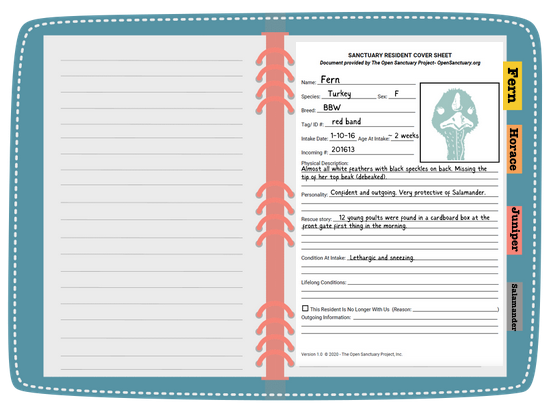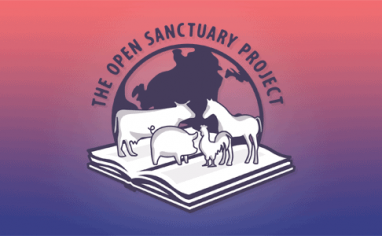
This resource has been fully reviewed and updatedA member of The Open Sanctuary Project’s staff has given this resource a full review and provided updates where necessary. by a member of The Open Sanctuary Project as of March 17, 2025. It was originally published on March 1, 2018.
One of the most important things that you can do for each of your residents may not be the most entertaining or glamorous job, but consistent record keeping kept in a safe, well-organized location is critical for resident health and safety, as well as the safety and success of your sanctuary. There are various forms and records referenced in our resources, and you may be wondering how to keep all these forms organized. If you haven’t yet, we strongly encourage you to check out The Open Sanctuary Project’s Animal Database, which was built on Airtable—a flexible, spreadsheet-database hybrid that lets you manage information about your residents in an easy-to-use format. All pertinent forms were built into the system, meaning once you enter in the data, it will automatically be organized and stored safely. To learn more about the features and functionality of The Open Sanctuary Project’s Animal Database and how to get started using it for your record-keeping needs, check out our in-depth resource here!
While we believe our Animal Database is going to be the easiest way for folks to keep everything organized, we realize some folks may need to stick with a predominately paper record-keeping system or a more basic digital system, so in this resource we’ll offer some guidance on how to keep resident records organized when using these types of systems.
Creating Individual Resident Records
Each resident should have their own permanent record. This record should be started soon after the intake process and added to and updated regularly. It’s very helpful to organize each of your residents’ permanent records in the same way, as this will make the retrieval of information easier. We recommend that each resident’s record contain the following, though there may be additional records you choose to include (for example, if someone has a long history of needing dietary modification, you may want to create a “Diet” subsection).
1. Resident Cover Sheet
Our Resident Cover Sheet serves as a brief overview of the individual. Once complete, it will contain pertinent information such as the individual’s name, species, breed, and sex, as well as their intake date, rescue story, and age at intake. You can also attach a photo and brief descriptions of what the resident looks like, their personality, their condition upon intake, and any lifelong health conditions or important alerts. As its name suggests, we recommend starting your resident’s permanent record with this sheet. You can download our Resident Cover Sheet here.
2. Intake Documentation
When you first bring a resident to your sanctuary, it’s important to keep good records of the intake process and everything you first learn about the resident. You can read more about conducting an intake evaluation here. At a minimum, this section should include their Resident Intake Record and Initial Health CheckThe Open Sanctuary Project uses the term "health check" to describe health evaluations performed by caregivers who are not licensed veterinarians. While regular health checks are an important part of animal care, they are not meant to be a replacement for a physical exam performed by a licensed veterinarian. Form, plus photo documentation of their incoming condition and distinguishing features. If they were examined by a veterinarian, be sure to include documentation of the visit. If they do not provide you with a write-up of the exam, you can use our Veterinary Visit Report Form to document the visit. The Intake Documentation section should also include a Resident Transfer Of Guardian Record and transport documentation (such as a Certificate of Veterinary Inspection, CVI), if applicable.
3. Resident Health And Treatment Information
This section will likely be one of the most substantial sections in their record because it will contain information about their health throughout the course of their lives. As such, it’s a good idea to break this section up into a few different subsections to make it easier to find the information you are looking for. We suggest the following subsections:
3a. Vaccinations
If your residents are vaccinated against certain diseases, it’s important to keep detailed records of all vaccinations they receive. There may be times when you need to quickly find information about when someone was last vaccinated, so it can be helpful to keep this information separate from other health information (though it’s not a bad idea to also record this information on the health history timeline, described below). Because sanctuaries tend to have residents of the same species on the same vaccination schedule (i.e., after their initial vaccines, boosters are administered to entire groups at the same time), some sanctuaries choose to maintain group vaccine logs for established residents who are on the same vaccination schedule rather than continuing to maintain individual logs for everyone. Either is fine so long as you can easily and accurately find information about who received which vaccines and on what date. You can find our Vaccine Log here. If your residents are vaccinated against rabies, be sure to keep their rabies certificates in their file (we recommend filing them in chronological order) or, if you were not provided with this (which may be the case if an entire resident population was vaccinated at the same time), record the vaccine brand and serial number along with the date it was administered and the veterinarian who administered it.
3b. Health History Overview/Timeline
Ultimately, this Resident Health And Treatment Information section will contain information about every health check, veterinary exam, diagnostic report, and treatment they have received. If individuals require a diet that is different from the standard diet you provide to others of their species or breed, this information can be kept in this section as well. This can add up to a lot of information, so we recommend creating a Resident Health History Overview/Timeline to help keep track of everything and make information easier to find. Think of this as a cross between a timeline and a table of contents that will make it easier to skim through their history to find pertinent information. Even if you save every single Health Check form and every Treatment Record and keep them filed and organized, it may be difficult to find the information you are looking for – especially for residents who have received long-term treatments or have been treated for multiple conditions. The same applies to Diagnostic Results and Veterinary Reports. It may not make sense or be easy to skim through multiple reports when searching for what you need. Even with a digital system that easily allows you to search for keywords, it can be helpful to have a timeline that shows a quick overview of their health history in chronological order.
How much information you include on the timeline may vary based on each sanctuary’s unique needs, but by keeping a running timeline and overview of treatments, special diets, health check findings, veterinary exams, and diagnostic testing, it can be much easier to find what you are looking for and to notice trends. In some cases, you may include all necessary information on the timeline. For example, you may include the specifics of a health condition, treatment details, and outcome. In other cases, you may just include a brief note and refer to an attached report. Here are a few examples of what an entry might look like on four different residents’ timelines:
12/7/15 – Continues on mash (3 cups Sentinel Senior mixed with 3 cups Timothy pellets) twice daily. Weight holding steady – 150 lbs.
1/27/16 – Routine health check performed. Northern fowl mites found. No other significant findings. See health check form for more details. Entire flock treated with Frontline spray.
7/1/19 – Left eye swollen shut in AM. Copious amounts of discharge. Tolerated a brief evaluation while having her belly rubbed. We were able to remove a large hayseed and flushed the eye with sterile saline. Called Dr. C. who suggested antibiotic eye drops twice daily. See treatment sheet.
4/15/20 – Recheck fecal post Levamisole treatment. 97% reduction in strongyles. See Diagnostic Report.
In the above examples, the timeline provides a snapshot of the individual’s health-related events. If the timeline doesn’t provide all the details you need, you can refer to the associated documentation easily because you now know the date the report was completed (hopefully you’ve filed paper reports in chronological order or included the date in the file name of digital records).
3c. Health Check Records
Even though pertinent information from health checks will be in the timeline, if at all possible, it’s a good idea to hold on to these records for future reference. Not only will this make it easier to compare future findings to past findings, it can also be very helpful for newer staff who may not be familiar with what is normal for each resident. Given the frequency of routine health checks, keeping physical copies of these records may result in way too much paper, so even if you are using a paper record-keeping system, you may want to scan these into one folder per resident and include the date in the file name to make them easier to find. At a minimum, we recommend keeping health check forms any time there are unusual findings or when you perform a health check in response to a concern.
More On Health Checks
Performing routine health checks is crucial. If this is not a topic you’re familiar with, be sure to check out our resource here. To learn more about the components of a health check for different species, check out our species-specific guides here. Each guide also contains a link to our downloadable Health Check forms!
3d. Veterinary Examination Reports
Veterinary care is a crucial aspect of sanctuary care, and it’s important to document all veterinary examinations. As with health check forms, having easy access to past veterinary examination reports allows you to compare current and past findings and to pinpoint when a certain issue started. Ideally, your veterinarian will give you a write-up of the visit, but if this is not the case, you and your staff must take thorough notes about the procedures or diagnostics performed, as well as any significant findings during the physical exam. You can download our Veterinary Visit Report form here.
3e. Diagnostic Results And Veterinary Interpretation
We recommend always asking your veterinarian for a copy of all diagnostic results so that you can include them in your residents’ records. It’s also important to include information about why the diagnostic test was performed (was this a routine screening test or was the individual showing signs of concern?) and to take thorough notes about your veterinarian’s interpretation of diagnostic results. If your veterinarian provides their interpretation in writing, you can simply include this with the results. If they offer their interpretation verbally, be sure to take good notes so that this information is not lost (or, better yet, ask them if they can write up their interpretation for your records). Having these reports can be helpful for comparison and to track trends.
3f. Resident Treatment Records And Special Diet Information
Every treatment your residents receive should be recorded. We suggest using our Ongoing Treatment and Observation Record or something similar. This will allow you to keep track of the important specifics of each treatment as well as daily observations about how the individual is doing. You can read more about how to best utilize a treatment record here. This form can also be used to record specific information about a special diet or feeding schedule. While we suggest including pertinent information on the individual’s overview/timeline, depending on the treatment, you may also want to keep the treatment record. In some cases, this may be tedious (an individual on a long-term treatment could have dozens of treatment records associated with just that one treatment), in which case, you’d want to very carefully record important information on their timeline. Simply stating that they were on a particular treatment for 6 months isn’t particularly helpful. You also want to include information about how they are responding to the treatment. If you use our Ongoing Treatment And Observation Record, there is an “Overall Assessment” section at the end where you can summarize how the individual is doing. This information can then be transferred to their timeline along with any other pertinent information.
4. Behavioral Assessments And Social Reports
While records related to your residents’ physical health are important, so too are records related to their behavior and how they respond to different situations. As with health information, having easy access to these records will allow you to look back at past findings, which may be useful if you want to compare them to current findings and/or if you are gathering information to make the best decision possible for an individual. To learn more about observing and recording resident behavior, check out our resource here. If one of your residents is particularly reactive to certain humans, residents, or situations, it is wise to also keep this information in a place where it is more prominent. This can help prevent problematic interactions down the road if a new volunteer or caregiver isn’t aware of the resident’s personality or how they react to certain situations.
5. Enrichment Records
Enrichment is an important part of ensuring residents thrive. However, a successful enrichment program entails more than just occasionally offering residents a treat or toy. A successful program involves planning appropriate enrichment, prepping the enrichment, setting up the enrichment, AND keeping records of the enrichment! You do this to evaluate the enrichment and ensure it is a positive experience and was successful for its intended purpose. You will want to record the individual(s) name(s), where their living area is, the date, the time (it’s more important than you might think!), a brief description of the enrichment activity/item, how it was presented, and how residents reacted to it at that moment and later on in the day. You can then get together as a team and evaluate whether the enrichment was successful, needs adjustments, or failed entirely. Be sure to record your findings!
6. Additional Forms For Residents Who Are No Longer In Your Care
It’s helpful to document the reason for a resident leaving your care, whether it be because they were adopted out to a new home or because they passed away. Consider using our Resident Adoption Record and Resident End-of-Life Record to keep track of the important details. When placing a resident in a new home, it’s a good idea to provide their new guardian with a copy of their permanent record, but you should also keep a copy for your files. If a resident passes away or is euthanized and a post-mortem examination is performed, be sure to include this in their file as well. Regardless of why they left your care, be sure to keep the full record of their life and times safely archived for future reference.
Keeping Everything Organized
If you care for just a handful of residents, you may not need much of an organizational system beyond what is described above. However, folks who care for more residents need to not only make sure each resident’s permanent record is properly organized, but also that they have a way to keep all their residents’ records organized so they can easily find what they are looking for. This is particularly important when working with a paper record-keeping system.
Sanctuaries caring for a smaller number of residents may prefer to give each individual their own binder, while sanctuaries caring for a larger number of residents or multiple species may opt for one (or more) larger binders that contain records for numerous residents. If you care for different species, it can be helpful to create species binders (i.e., your chicken resident binder would contain permanent records for all your current chicken residents).
A species binder might be organized like this:
- Group Vaccine Log – As mentioned above, if your residents are vaccinated regularly and are on the same vaccination schedule, it can be easier to record this information on a general Vaccine Log rather than on each individual’s chart. It typically makes sense to record incoming vaccine information in the individual’s record since that information will be unique to them, and they will be on their own initial schedule while getting any necessary boosters. As a side note, when using The Open Sanctuary Project’s Animal Database, you can use our Group Vaccine form to enter in vaccine information for an entire group once and then the system will automatically add the information to all residents in that group!
- Group Treatment Logs – Similar to the Group Vaccine Log, if other group treatments are administered, such as an entire group being treated for external parasites, it may be helpful to record this information on the Group Treatment Log rather than on each resident’s individual record. There’s no right or wrong here – just make sure the system you use makes it easy to find what you need later on, and make sure to record group information in a way that will provide the information you need in terms of who received what and when they received it.
- Current Residents’ Permanent Records – When using one binder to hold records for multiple individuals, it’s a good idea to use tabs or dividers labeled with each individual’s name in order to keep each resident’s record separate and easier to find. We also recommend organizing the binder so that the residents are in alphabetical order.

Back-Up Your Records!
One major drawback of paper record-keeping systems is that if anything happens to the physical copy, the information it contains will be lost. Therefore, it’s a very good idea to back up your paper system so that information is not lost in the event of lost or damaged physical copies. Scan or take photos of important documents so that you can have a backup of important records. Even digital records are at risk of being lost if they are only saved to your hard drive. We recommend using cloud storage or otherwise backing up digital files so they are not lost if something happens to your computer.
Organizing Past Residents’ Permanent Records When Using A Paper System
An individual’s permanent record continues to be important and valuable long after they leave your care, and there are a variety of reasons why you may want or need to refer to these records in the future. If a past resident was diagnosed and treated for a condition that is not commonly seen at your sanctuary, you may find yourself in a position in the future where you need to revisit that information if another resident develops the same condition. Being able to revisit what treatments did or didn’t work in the past (and why) can be very useful when making decisions for current residents. Unfortunately, using a paper system (rather than a digital system) does make this type of search a bit more difficult – someone needs to remember which resident’s file will have the information you are looking for rather than just being able to do a keyword search, but it’s better than losing the information all together.
While you definitely want to hold on to records for residents who are no longer in your care, things can get overwhelming and confusing if they continue to be kept along with current residents’ records (particularly if you care for many residents). Depending on how much space you have, you may wish to store these files in an area that is out of the way but still accessible when needed. Chances are that you will be accessing these files much less often than the permanent records for current residents. Filing cabinets or filing boxes can be useful for storing and organizing paper records for residents who are no longer in your care. If you only care for a small number of individuals, you might not have to put a whole lot of thought into how you do this since you’ll only have a small number of records to go through, but sanctuaries that care for large numbers of residents or that are in operation for many years could have a large number of records that need to be kept organized. One system that has worked for other sanctuaries is to organize past resident records by the year they left your care (though this means that this information must be easy to access without referring to their file*). Each year might have its own box (or boxes) or a designated drawer in your filing cabinet. You can then organize the records in alphabetical order to make them easier to find. If your organization has an adoption program, you may want to keep records for residents who have been adopted out separate from those who are deceased.
*Consider Using A Hybrid System
Even if your record-keeping system is primarily a paper system, it may be useful to have at least some information kept digitally. Think about the information you need in order to easily find an individual’s record (based on your organization system) and maintain a digital copy of this information so that it is easily accessible. Maybe this is a spreadsheet of all the individuals who have ever lived at your sanctuary, along with pertinent information (such as their species, breed, sex, incoming date, and, once they leave your care, their outgoing date and reason for leaving your care).
A Note On Record Storage
Paper records should be safely kept in a cool, dry, and secure location. Consider the proximity of things like windows, water pipes, and gas pipes to record storage, and keep storage off the floor to prevent damage from flooding or insect infestation. Record storage should be regularly monitored to check for any kind of damage or risk of damage. Consider maintaining critical documents in a secure off-site location, also in a manner protected from damage or loss. A safe deposit box is an option, and so are off-site fire and flood-proof safes. Keeping additional copies of such documents in yet another location so that both originals and copies are not destroyed in a single calamity is also recommended. Ensuring that multiple people have access not only to originals but also off-site copies is wise in case of an emergency.
Once you’ve settled on an organizational system that works for your sanctuary, be sure to make time to maintain your residents’ records! You can read more about how to do this here.
SOURCES:








